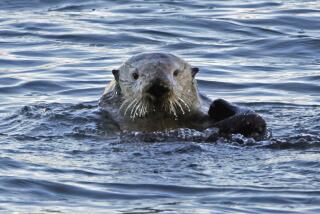Science / Medicine : Even the Lowly Louse Has Its Champions
It is no accident that World Wildlife Fundâs symbol is the adorable giant panda, and that American conservationistsâ mascot is the handsome bald eagle--instead of the equally endangered pygmy hog-sucking louse, the eyeless crayfish, or the pearly mussel.
âItâs hard to get people sentimental over a snail or a insect or an isopod,â admitted David Klinger, spokesman for the U.S. Department of the Interiorâs Endangered Species Program.
Yet, worldwide, an estimated half a million species of small, spineless animals known as invertebrates--including insects, spiders, crayfish, clams, snails, crabs, slugs and worms--are in danger of extinction. They are threatened by the same forces that put the larger, more charismatic animals in danger: pollution, pesticides, bulldozers, even hunting--butterfly and shell collectors take their toll.
And, in many cases, the disappearance of invertebrates spells doom for the higher animals that depend on them for food: âThey might have funny names and they may be obscure, but if you lose the bugs, you lose the higher animals as well,â Klinger said.
Although trying to save ugly bugs and slimy snails from extinction poses a bit of a public relations problem, conservationists are now focusing unprecedented attention on endangered invertebrates. Today the United States hosts at least a dozen preserves for moths, butterflies, crustaceans and snails, established by private nonprofit groups such as the Nature Conservancy and the Xerces Society (an insect conservation group named after an extinct butterfly).
In New Zealand, entomologist Mike Meads of that countryâs Department of Scientific and Industrial Research recently completed the first successful translocation of an endangered insect. If he had not moved 43 fist-sized crickets called giant wetas from a rat-infested New Zealand island, where the rodents were gorging themselves on the wetas, to a rat-free area, this ancient insect species would be extinct today.
And that transplantation paved the way for Japanâs effective translocation program for colonies of endangered wood ants.
U.S. Interior Department specialists are now reviewing a list of 1,021 invertebrate species--including the little winged pearly mussel, the California freshwater shrimp, the speckled pocketbook mussel, and five Texas cave invertebrates--as candidates for federal protection.
But sticking up for invertebrates takes some backbone. When the International Union for the Conservation of Nature and Natural Resources published its landmark Invertebrates Red Data Book in 1983, âWe knew we were laying ourselves open for ridicule,â said Robert Pyle, a butterfly specialist who conceived and edited this first book on endangered invertebrates. Among the species it listed in need of protection was a louse from India that lives as a parasite on an equally endangered pygmy hog; the entry sparked an uncomplimentary spoof in the Wall Street Journal.
Sociobiologist E. O. Wilson, a director of the World Wildlife Fund, likens this attitude to that of our great-grandparents in the 1800s: âThey were as oblivious to birds and mammals as we are to invertebrates today,â said the Pulitzer Prize-winning author and scientist, who shares his Harvard laboratory with 10,000 Amazonian leaf-cutting ants. âMaybe the next generation will be well enough informed and care enough about invertebrates as we do today about mammals and birds.â
Increasingly, evidence is accumulating to show that invertebrates are crucial as both human resources and ecological building blocks. Pyle points out that invertebrates, making up nine-tenths of animal life on Earth, are major components of food chains, help maintain soil fertility and recycle nutrients. Many are essential to plant pollination; many orchids, for instance, rely entirely on one particular species of insect for their own propagation. If that insect became extinct, so would the orchid.
Other invertebrates are medically useful--even the medicinal leech has regained its popularity: the bloodsuckers were used recently in conjunction with the microsurgical reattachment of a Boston boyâs severed ear. And let us not forget the value of invertebrates like the silkworm; other insect species are used to produce dyes.
The disappearance of some threatened species would leave us bereft of some of the Earthâs most beautiful and fascinating species. Hawaiiâs Oahu tree snails, for instance, bear conical shells like living jewels. No two shells are colored or patterned alike. But Pyleâs book shows the snails under fire from introduced predators, including another, carnivorous snail, and scientists fear there may be less than 100 of these tree snails left today.
Worldwide populations of horseshoe crabs are also declining. The massive emergence of these arthropods on beaches of Atlantic Ocean and Gulf of Mexico shorelines is one of the most spectacular natural events offered on North American shores. The horseshoe crab and its eggs are used for food in some countries, and in our own are valued for medical applications, ranging from using its extracts for human gonorrhea tests to studying its eyes to better understand our own. But millions of horseshoe crabs are killed by clam diggers because they feed on clams.
Happily, however, the public is catching the conservation spirit, and is beginning to see beyond the old idea that invertebrates were there to swat, spray or step on.
One example is Plainfield, N.H. Last July 4, while the rest of the nation was fussing with icons such as the American flag and the Statue of Liberty, this tiny town rallied âround a half-inch-long burrowing beetle. Two years ago, the town learned that the endangered cobblestone tiger beetle had taken up residence there, and it was adopted as the town insect. Today it is the centerpiece for the townâs Independence Day parade, and proceeds from sales of T-shirts bearing the beetleâs image go toward protecting its riverside habitat.
Unfortunately, the poor pygmy hog-sucking louse holds no such claim to superstar status. It is, quite literally, an ugly sucker. But Pyle still defends the animal. âRegardless of whether it has an obvious use or importance, it is clear that all creatures evolved in concert with the ecosystem, and their removal would obviously have an impact on it--probably deleterious.â
The experience of Papua, New Guinea, shows that the payoff for preserving invertebrates can be lucrative. The nation, occupying part of a large island off the north coast of Australia, realized that uncontrolled collection of its exotic butterfly, stick insect and beetle species could rob the country of an important resource by depleting the populations of those insects. So the country instituted an Insect Farming and Trading Commission, which helped villagers create specially planted insect farms, mostly for butterflies. Only half of the insects are harvested and sold to collectors; the rest fly free. Today, formerly threatened species are thriving.
But conservationists say the value of saving any species eludes a price tag. The richness and diversity of the Earthâs splendid array of life--from lice to men--are worth a great price to keep. While some shortsighted people might defend killing off some invertebrate species on economic grounds, Wilson said, âit is like burning Renaissance paintings to cook dinner.â
FOOD CHAIN BINDS HIGHER ANIMALS TO LOWLY INVERTEBRATES
They may not be cuddly, but most invertebrates prove invaluable to the food chain leading to more complex animals. Here is one example.
Spineless Animals Get Conservationists Attention
Brine Shrimp
Herring
Gentoo Penguin
Leopard Seal
Killer Whale
THE INVERTEBRATES
There are more than a million known species of animals that have no spine and many forms of animals. These are the phyla or major groupings:
Phylum Description Example Protozoa Microscopic animals made up of Amoeba a single cell Porifera Pore-bearing sponges. Coral Coelenterata Animals with hollow cavities Jellyfish Platyhelminthes Worms with flat bodies Tapeworm Aschelminthes Worms with round bodies Hookworm Annelida Worms with segmented bodies Earthworm Echinodermata Animals with external spines Sea Urchin Mollusca Soft-bodied animals with hard, limey shells Clam Arthropoda Animals with jointed legs, Insects outer skeleton of chitin
More to Read
Sign up for Essential California
The most important California stories and recommendations in your inbox every morning.
You may occasionally receive promotional content from the Los Angeles Times.










